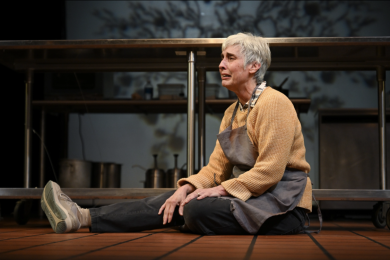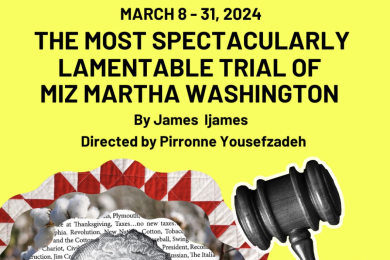The Skriker
Caryl Churchill is a playwright’s playwright. Her thick language, changeable tempo, and deep commitment to experimentation have caused some to herald her as the greatest living playwright. Known for her political bent and constant reinvention, her works often lay somewhere between magical realism and the real world. Fortune’s Fool Theatre’s presentation of The Skriker, admittedly one of Churchill’s less famous plays, attempts to delve into the deep psychosis of this fairy/horror story, but seems to fall flat. The best parts of this staging of The Skriker are when it doesn’t try so hard, and its lowest points are when it overplays its hand.
In a nutshell, the Skriker (Ariel Leaf) is a fairy creature, possibly the embodiment or at least related to the natural world, who in our present era has become twisted and mis-formed. She latches on to particular humans, granting their wishes in Cronenbergian ways. Like the original fairy tales, whose purpose was to instruct on the cruelty of the world and the social penalties for nonconformity, the Skriker punishes those she helps and hurts the ones she tries to love. Confronted by her again and again in various different guises, two young women from Margaret Thatcher’s England try in vain to navigate their own complex relationship to their children and each other.
When we first meet Josie (Gabrielle Dominique), she is in a mental hospital, having been suspected of killing her young child. Here, she is haunted by the Skriker. When her pregnant friend Lily (Haley Sisler), comes to visit her, the Skriker latches on to her as well. While other things happen in the script, this is the main and recurring tension -- the Skriker wants the two women, and impersonates almost everyone else they meet from then on out in an attempt to seduce and recruit them. The Skriker is the embodiment of Descartes evil genius, for she has twisted the whole world to confuse and ensnare our would-be heroines. They can never trust their senses or their human interactions as the Skriker is always there manipulating them. Interspersed is new music by local composer Keith Hovis, whose compositions are properly eerie but show sophisticated restraint.
I don’t envy Leaf, who has the hardest part of the evening. Her nearly endless pages of dialogue fall somewhere between poetry and madness, and the fact that she committed to memorizing this play is in and of itself a labor of love. With lines like these, there are two main ways an actor can go: a) they can slow down and attempt to inject gravitas and meaning, or b) they can play up zany aspects and go full Animaniacs. Leaf is definitely in camp b, which is helpful as this is a one act and she must have, conservatively, 70% of the lines. Her performance is zealous and quite humorous, but most of her lines are so broadly modulated that they become unintelligible. A better mic-ing situation or a slightly slower pace would have greatly aided my appreciation of the piece.
Having done and seen such theatre before, I could certainly imagine that with several more nights in front of a live audience she may settle down and hit her stride. Dominique and Sisler’s performances are necessarily quieter than Leaf’s. There is a real chemistry between the two and some of their more tender scenes with each other are the highlights of the play. Dominique’s characterization straddles the line between madness and clarity, complimenting Sisler’s naivete.
Similar to Leaf’s portrayal, the decision to set the whole play in a cellophane-coated underworld shows a lack of restraint palpable in the rest of the play. It is not that I didn’t like this set by Seán McArdle, in fact it was quite evocative. Rather, it was the fact that there was no real change of scenery, a choice effectively made for this production by The Crane’s unique and rather immovable space. This rootedness doesn’t do The Skriker many favors. The Skriker herself already injects so much slippage into the play (after all, she inserts herself into almost every scene) that this additional imposition of the underworld onto every scene robs the production of some of its potential ambiguity. I would have liked to wander through the quagmire of Churchill’s language a bit less moored to such a physical manifestation of the underworld. This is particularly true because an equally compelling reading of this play is Josie’s mental illness, which might mean that the Skriker is actually a manifestation of Josie’s postpartum depression and her unbearable guilt. “What can a ten day old baby do that’s naughty?” Josie miserably explains to her Lily, who is seemingly oblivious to the danger she and her own baby could soon be in.
The decision to make the fairy creatures more like highly-stylized, crazed zombies, complete with cartoony halloween makeup, is charitably reminiscent of Beetlejuice, with all the problems that comparison entails. This is a fresh faced (and numerous!) cast, and you can feel they have buy in. They writhe, lurch, and lurk, with inspiration rooted in horror tropes and perhaps The Walking Dead. Often their ancillary movements, unconnected to the scenes at hand, feel unwarranted, but this is hardly their fault. The makeup and group performance, coupled with the set and Leaf’s characterization, made me wonder if perhaps the director worried that the script itself wasn’t engaging enough. These choices get to the heart of the problem with this staging -- instead of letting the audience wallow in the ambiguity (Why did Josie kill her baby? Why has the Skriker become so crazed? Where are we and in what time?), every path is cut short in favor of a cleaner answer. While that is occasionally more satisfying, in the case of The Skriker I would have preferred to be adrift. Nevertheless, it is quite an ambitious undertaking for Fortune’s Fool, and shows they are willing to take big risks and push a large cast towards increasing heights. Such ambition is admirable, and I would certainly continue to look out for their productions in the future.




